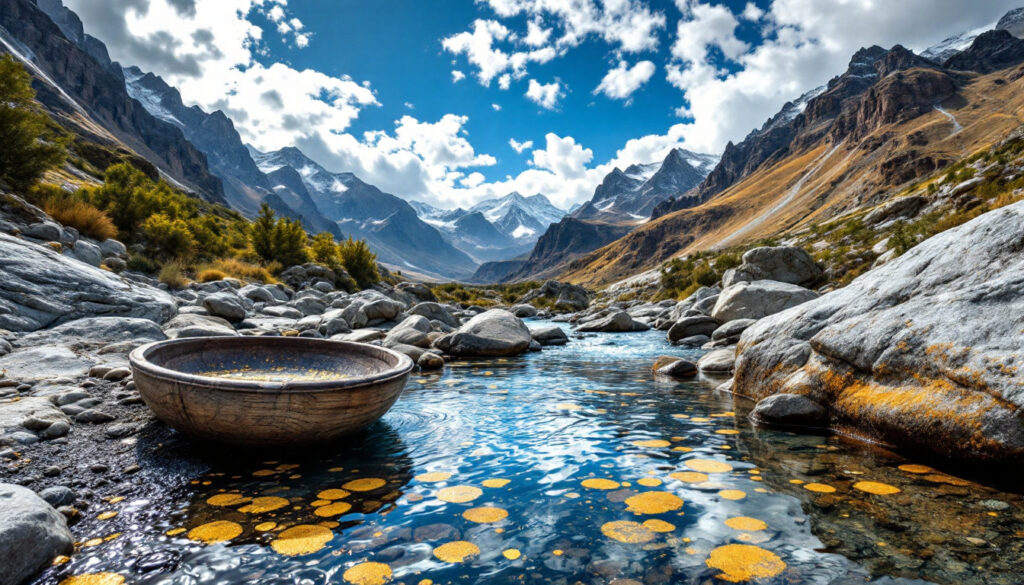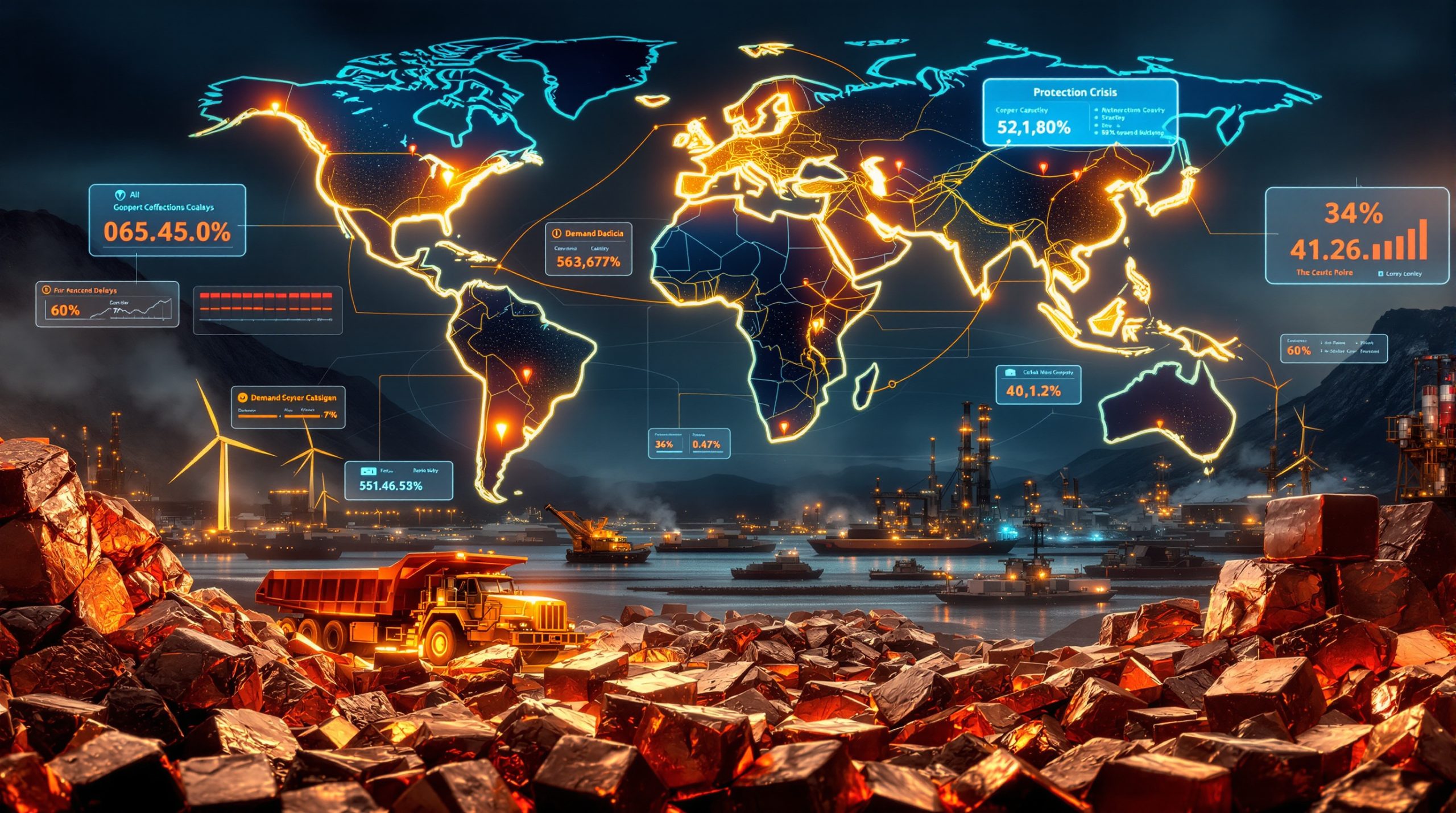What Are the Primary Sources of Gold in Nature?
Gold naturally occurs in two primary forms, each with distinctive characteristics and formation processes that determine where prospectors and mining companies focus their efforts.
Hard Rock (Lode) Deposits
Hard rock deposits represent nature's original gold sources, forming deep beneath the Earth's surface through complex geological processes. These deposits originate when mineral-rich hydrothermal fluids—essentially superheated water containing dissolved metals—circulate through fractures in the Earth's crust during periods of intense volcanic and tectonic activity.
When these mineral-laden fluids cool and depressurize, they deposit gold along with other minerals in veins, primarily in quartz formations. This process, occurring at temperatures between 150-300°C, creates the classic white quartz veins streaked with gold that miners have sought for centuries.
Typically, gold in these primary deposits exists as microscopic particles invisibly dispersed throughout the host rock, with concentrations often less than 10 grams per ton. While these seem like minute amounts, hard rock deposits account for approximately 60% of global gold production due to their scale and persistence with depth.
The extraction of lode gold requires sophisticated industrial mining operations involving drilling, blasting, crushing, and complex processing methods including cyanide leaching to recover the precious metal. Notable examples include South Africa's Witwatersrand Basin, which has yielded approximately 40% of all gold ever mined in human history.
Placer Deposits: Nature's Gold Collectors
Placer deposits represent nature's way of concentrating gold through erosion and water movement. When gold-bearing rocks weather and break down over millions of years, the incredibly dense gold particles (19.3 times heavier than water) gradually separate from lighter materials.
Rainwater and streams wash these gold particles downslope, where they accumulate in stream beds, river bends, and ancient buried channels. Gold's remarkable density causes it to settle in specific locations within these waterways—behind boulders, in crevices, and along bedrock contacts where water flow slows.
These secondary deposits typically contain gold in more visible forms: flakes, dust, and occasionally larger nuggets that can weigh several ounces or even pounds. The largest verified gold nugget ever discovered—the Welcome Stranger found in Australia in 1869—weighed an astonishing 2,316 troy ounces (72 kg) and came from a placer deposit just inches below the surface.
Placer deposits fueled history's most famous gold rushes, including California's 1848 gold rush which produced approximately 750,000 pounds of gold over a decade. Their accessibility to individual prospectors—requiring only simple equipment like pans, sluices, or dredges—continues to make them popular for recreational gold hunting today.
Which Geological Settings Favor Gold Formation?
Understanding the geology of ore deposits helps explorers target their search efforts more effectively.
Ancient Volcanic Environments
Some of Earth's richest gold deposits occur in greenstone belts—ancient volcanic-sedimentary formations dating back 2.5-3.8 billion years. These archaic landscapes, predominantly found in cratons (stable continental cores) across Canada, Australia, and Africa, formed during Earth's early crustal development.
Canada's Abitibi greenstone belt exemplifies these ancient gold-hosting environments, containing numerous world-class deposits that collectively contribute to annual production exceeding 2 million ounces. The ancient volcanic rocks in these regions underwent extensive metamorphism and deformation, creating ideal pathways for gold-bearing fluids.
What makes these settings so productive for gold formation is their complex geological history, involving multiple episodes of magmatic activity, metamorphism, and structural deformation that provided both gold sources and the mechanisms to concentrate it.
Continental Collision Zones
Orogenic belts, formed during mountain-building events where tectonic plates collide, provide ideal conditions for gold deposit formation. These dynamic zones generate the heat, pressure, and fluid migration pathways necessary for mobilizing and concentrating gold.
"Orogenic belts like the Rocky Mountains create ideal gold-forming conditions through crustal compression and fluid migration," explains Dr. Richard Goldfarb, a leading researcher in the field of economic geology at the Colorado School of Mines.
These settings produce extensive networks of gold-bearing veins that follow fault systems and fracture networks, with examples including North America's Rocky Mountains, the European Alps, and the Tian Shan belt across Central Asia. Notably, the California Mother Lode system formed during the Mesozoic collision between the Pacific and North American plates.
Near-Surface Hot Spring Systems
Epithermal deposits form relatively close to Earth's surface (within 1-2 kilometers) in association with recent volcanic activity and hot springs. These systems create distinctive mineral patterns and can contain exceptionally high-grade gold concentrations in relatively confined areas.
At Hishikari in Japan, epithermal veins have yielded spectacular bonanza grades reaching 40 grams per ton, making it one of the world's richest gold mines. These deposits typically feature distinctive textures such as banded quartz and adularia, providing visual clues for prospectors.
Modern analogues for these ancient systems can be observed in active geothermal fields like New Zealand's Taupo Volcanic Zone and Yellowstone National Park, where gold-bearing fluids currently circulate beneath hot springs.
Intrusive-Related Systems
When granitic magma intrudes into surrounding country rocks, it can introduce gold and other metals through a process called hydrothermal alteration. These intrusive-related systems often create large, disseminated deposits where gold occurs alongside copper, molybdenum, and other metals.
Porphyry-style deposits, critical for commercial mining operations, typically contain lower gold grades (0.5-1 gram per ton) but compensate with enormous volumes of mineralized rock. The Bingham Canyon mine in Utah exemplifies this deposit type, producing gold as a valuable by-product of copper mining.
What makes these systems economically important is their scale and amenability to bulk mining methods, allowing profitable extraction despite relatively low grades.
How Can You Recognize Signs of Gold in Nature?
Identifying potential gold-bearing terrain requires understanding several key indicators that can lead prospectors to discoveries.
Quartz Vein Indicators
White or milky quartz outcrops represent one of the most promising visual indicators for potential gold mineralization. These silica-rich formations result from the same hydrothermal processes that transport and deposit gold.
The most prospective quartz veins typically show distinctive characteristics: iron staining (rusty or yellowish coloration), weathering that creates a honeycomb texture, and visible inclusions of other minerals like pyrite. Multiple parallel veins in an area significantly increase gold potential.
Field studies have demonstrated that not all quartz contains gold, but almost all primary gold is associated with quartz. Prospectors should particularly focus on fractured or "sugary" quartz with irregular textures rather than solid, glassy varieties.
"The presence of iron-stained quartz with sulfide minerals is one of the most reliable visual indicators for potential gold mineralization in hard rock settings," notes veteran prospector Dave McCracken, who has documented extensive research on gold indicators in California's mining districts.
Iron Staining and Oxidation Patterns
Rusty or orange-colored rocks often signal the presence of iron sulfide minerals like pyrite, which frequently accompany gold. When these sulfides oxidize near the surface, they create distinctive yellow, red, or brown staining in surrounding rocks and soil.
Gossans—heavily oxidized, iron-rich surface zones—may cap gold ore bodies, creating rusty outcrops visible from considerable distances. These rusty zones result from the decomposition of sulfide minerals that commonly accompany gold deposition.
In desert environments, desert varnish (a dark mineral coating on exposed rock surfaces) can sometimes indicate the presence of gold-bearing systems beneath. Prospectors in Nevada's gold districts have long recognized these subtle coloration patterns as potential indicators of mineralization.
Black Sand Concentrations
Heavy, dark minerals that accumulate in stream beds provide one of the most reliable indicators for placer gold. These "black sands," primarily composed of magnetite, hematite, and other dense minerals, settle alongside gold due to similar physical properties.
The presence of black sand concentrations in stream sediments, particularly when they contain garnet (red) or ilmenite (black with metallic luster), significantly increases the likelihood of finding gold. Modern prospectors often use magnets to separate these materials during processing.
These heavy mineral concentrations accumulate in the same locations as placer gold: inside river bends, behind boulders, upstream from obstacles, and in bedrock crevices. Experienced prospectors check these natural gold traps first, knowing that visible black sand almost always indicates the proper environment for gold deposition.
Geological Alteration Zones
Areas where rocks show visible changes due to hydrothermal fluids provide important clues for gold exploration. These alteration zones may extend well beyond the actual gold deposit, creating a larger target for prospectors.
Clay-rich or bleached rocks often indicate hydrothermal alteration, as do zones of silicification where increased quartz content makes rocks notably harder than surrounding material. Sericitic alteration, creating fine micas, or argillic alteration, forming clay minerals, commonly surrounds gold deposits.
Advanced exploration companies map these alteration patterns using satellite imagery and spectral analysis, but even amateur prospectors can recognize the color and hardness changes that signal potential mineralization.
Where Are the World's Major Gold Producing Regions?
Gold production spans the globe, with both historical and emerging regions contributing to the current supply.
Leading Gold Producing Countries
China currently leads global gold production with approximately 380 metric tons annually, primarily from mines in the eastern provinces of Shandong and Fujian. The country's output has increased dramatically since the early 2000s through modernization of mining practices and government incentives.
Australia follows closely with 320 metric tons yearly, focusing on operations in Western Australia's Kalgoorlie region and the northeastern state of Queensland. The Super Pit in Kalgoorlie alone produces approximately 700,000 ounces annually from an open pit mine visible from space.
Russia maintains steady production around 300 metric tons annually from significant operations across Siberia and the Far East, particularly in the Magadan and Amur regions. The country's resources remain somewhat underexplored, with new discoveries continuing to emerge in remote areas.
The United States produces approximately 190 metric tons yearly, with Nevada alone accounting for about 75% of domestic production. The Carlin Trend in northeastern Nevada represents North America's most productive gold region, with numerous mines operating along this 50-mile geological feature.
Canada contributes about 180 metric tons annually from major operations in Ontario, Quebec, and British Columbia. The country's mining expertise has developed sophisticated underground methods for extracting gold from deep deposits.
South Africa, once the world's dominant producer, has seen output decline to approximately 120 tons yearly from historical peaks exceeding 1,000 tons in 1970. The country's ultra-deep mines, reaching depths beyond 4 kilometers, face economic challenges despite still containing substantial reserves.
Iconic Gold Mining Districts
The Witwatersrand Basin in South Africa represents Earth's largest gold resource, having yielded more than 52,000 tons historically—approximately 40% of all gold ever mined. This ancient paleochannel system contains sedimentary deposits formed 2.8 billion years ago.
Nevada's Carlin Trend hosts disseminated microscopic gold in sedimentary rocks, with total resources exceeding 70 million ounces. Discovered in the 1960s, this district revolutionized understanding of "invisible gold" deposits where the precious metal cannot be seen without microscopic examination.
Kalgoorlie in Western Australia has maintained continuous production for over a century, with the famous "Golden Mile" containing exceptionally rich ore bodies. The region's geological setting—an Archean greenstone belt—provides ideal conditions for large-scale gold formation.
The Abitibi Greenstone Belt spanning Ontario and Quebec constitutes North America's richest gold region, hosting over 100 separate deposits. Major mines like Timmins, Kirkland Lake, and Val d'Or have produced continuously for decades, with new discoveries still occurring.
Uzbekistan's Muruntau mine operates as one of the world's largest open-pit gold operations, producing approximately 2.6 million ounces annually. Though detailed information remains limited due to government restrictions, the deposit's scale places it among the most significant global resources.
Emerging Gold Frontiers
West Africa has rapidly developed into a major gold province, with Ghana, Mali, Burkina Faso, and Côte d'Ivoire collectively producing over 320 tons annually. The region's Birimian greenstone belts share geological similarities with Australia's productive terrains.
Ecuador and Colombia represent significant untapped potential in South America's northern Andes. Projects like Fruta del Norte in Ecuador (reserves of 9.5 million ounces) demonstrate the region's prospectivity despite historical underexploration due to political factors.
Eastern Russia contains vast territories with minimal modern exploration, particularly in the Siberian Platform and Far East regions. Recent discoveries suggest considerable potential for new world-class deposits as infrastructure improves access to remote areas.
Deep-sea deposits increasingly attract interest as technological capabilities advance. Hydrothermal vent systems along mid-ocean ridges contain significant gold concentrations, though environmental concerns and technical challenges currently limit commercial development.
Historical mine tailings present opportunities for gold recovery using improved technologies. Sites in South Africa, Australia, and North America where historical recovery methods captured only 60-80% of available gold now undergo reprocessing with modern gold mining innovations achieving over 95% recovery.
What Unusual Places Can Gold Be Found?
Beyond conventional deposits, gold occurs in several unexpected environments that may contribute to future supply.
Oceanic Gold Sources
Active hydrothermal vent systems on the ocean floor, known as "black smokers," discharge mineral-rich fluids containing significant gold concentrations. These underwater hot springs, typically found along mid-ocean ridges, continuously deposit polymetallic sulfides enriched in gold, copper, and other valuable metals.
Seawater itself contains dissolved gold, albeit at extremely low concentrations of 0.01-0.05 parts per billion. While these trace amounts total approximately 20 million tons of gold throughout Earth's oceans, current technology cannot economically extract it. Historical attempts, including Fritz Haber's post-World War I experiments, demonstrated the technical feasibility but economic impracticality of oceanic gold recovery.
Deep-sea mining remains largely experimental, with companies like Nautilus Minerals developing specialized equipment for seafloor massive sulfide extraction. Recent test deployments of collector robots like DeepGreen's Patania II demonstrate advancing capabilities, though commercial operations face significant environmental and regulatory hurdles.
Polymetallic nodules and crusts on the deep ocean floor contain recoverable gold (approximately 0.5 grams per ton) alongside more abundant metals like manganese, cobalt, and nickel. These deposits, found primarily in the Clarion-Clipperton Zone of the Pacific, represent a potential future resource currently under exploration by several international consortia.
Extraterrestrial Gold
Meteorites contain trace amounts of gold, providing evidence for the metal's cosmic origin. Chemical analysis of gold-bearing meteorites reveals distinctive isotopic signatures formed during supernova explosions before Earth existed.
Astrophysicists have determined that gold forms through rapid neutron capture (r-process nucleosynthesis) during neutron star collisions and certain supernova explosions. This cosmic origin explains why where is gold found in nature – predominantly in Earth's crust rather than its core, having arrived after the planet's initial formation and differentiation.
Near-Earth asteroids represent potential future resources, with some containing significant gold concentrations alongside platinum group metals. NASA's Psyche mission, scheduled to explore a metal-rich asteroid, aims to improve understanding of these extraterrestrial mineral deposits.
Current spectrographic analysis suggests certain metallic asteroids may contain gold grades substantially higher than Earth's richest mines, potentially reaching hundreds of grams per ton. While space mining remains conceptual, companies like Planetary Resources and Deep Space Industries have conducted preliminary research on extraction methodologies.
Electronic Waste
Modern electronics contain recoverable gold in circuit boards, connectors, and components, creating "urban mines" of increasing importance. One ton of smartphones contains approximately 350 grams of gold—significantly higher concentration than most natural ores.
Global e-waste generation exceeds 50 million tons annually, containing an estimated $62.5 billion worth of precious metals including 320 tons of gold. However, current recovery rates remain below 20% globally, representing both an environmental challenge and economic opportunity.
Companies like Belgium's Umicore have developed sophisticated processes that recover 99% of gold from electronic scrap, processing approximately 350,000 tons of e-waste annually. These urban mining operations increasingly supplement traditional mineral extraction as ore grades decline in conventional mines.
The circular economy approach to gold recovery from electronics reduces environmental impact while providing an important secondary supply source. Japan, facing limited natural resources, has pioneered these technologies, with Tokyo's Olympic medals in 2021 manufactured entirely from recycled electronic gold.
Invisible Gold Forms
Refractory gold, trapped within sulfide mineral structures (particularly arsenopyrite and pyrite), represents a significant resource often overlooked by historical mining operations. This "invisible gold" requires specialized processing techniques like bio-oxidation or pressure oxidation to release the precious metal.
Pyrite can contain gold concentrations ranging from 0.1-5 parts per million without showing any visible evidence, making microscopic and chemical analysis essential for identification. In Nevada's Carlin
Want to Discover the Next Major Mining Opportunity?
Discover the next significant mineral discovery before the market reacts with Discovery Alert's proprietary Discovery IQ model, delivering real-time alerts on ASX announcements with exceptional potential. Explore our dedicated discoveries page to understand how major mineral discoveries have historically generated substantial returns for early investors.




